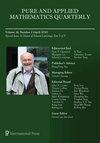排列的量子复杂性
IF 0.8
4区 数学
Q3 MATHEMATICS
引用次数: 0
摘要
让 $S_n$ 的所有排列的对称群 $\{1, \cdots, n\}$ 用两个发电机:换位开关 $1$ 有 $2$ 循环排列发送 $k$ 到 $k+1$ 为了 $1\leq k\leq n-1$ 和 $n$ 到 $1$ (表示为 $\sigma$ 和 $\tau$). 在本文中,我们研究了中排列的量子复杂性 $S_n$ 使用 $\{\sigma, \tau, \tau^{-1}\}$ 作为逻辑门。中置换的一个显式构造 $S_n$ 具有二次量子复杂度下界 $\frac{n^2-2n-7}{4}$。我们也证明了所有的排列 $S_n$ 二次量子复杂度有上界吗 $3(n-1)^2$。最后,我们证明了 $S_n$ 二次量子复杂度的下限是什么时候 $n\rightarrow \infty$.本文章由计算机程序翻译,如有差异,请以英文原文为准。
Quantum complexity of permutations
Let $S_n$ be the symmetric group of all permutations of $\{1, \cdots, n\}$ with two generators: the transposition switching $1$ with $2$ and the cyclic permutation sending $k$ to $k+1$ for $1\leq k\leq n-1$ and $n$ to $1$ (denoted by $\sigma$ and $\tau$). In this article, we study quantum complexity of permutations in $S_n$ using $\{\sigma, \tau, \tau^{-1}\}$ as logic gates. We give an explicit construction of permutations in $S_n$ with quadratic quantum complexity lower bound $\frac{n^2-2n-7}{4}$. We also prove that all permutations in $S_n$ have quadratic quantum complexity upper bound $3(n-1)^2$. Finally, we show that almost all permutations in $S_n$ have quadratic quantum complexity lower bound when $n\rightarrow \infty$.
求助全文
通过发布文献求助,成功后即可免费获取论文全文。
去求助
来源期刊
CiteScore
0.90
自引率
0.00%
发文量
30
审稿时长
>12 weeks
期刊介绍:
Publishes high-quality, original papers on all fields of mathematics. To facilitate fruitful interchanges between mathematicians from different regions and specialties, and to effectively disseminate new breakthroughs in mathematics, the journal welcomes well-written submissions from all significant areas of mathematics. The editors are committed to promoting the highest quality of mathematical scholarship.

 求助内容:
求助内容: 应助结果提醒方式:
应助结果提醒方式:


